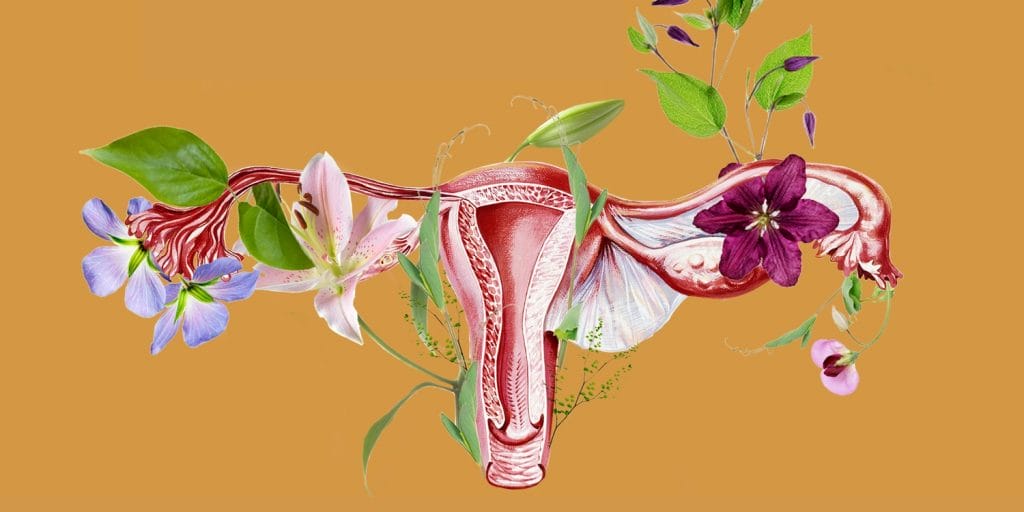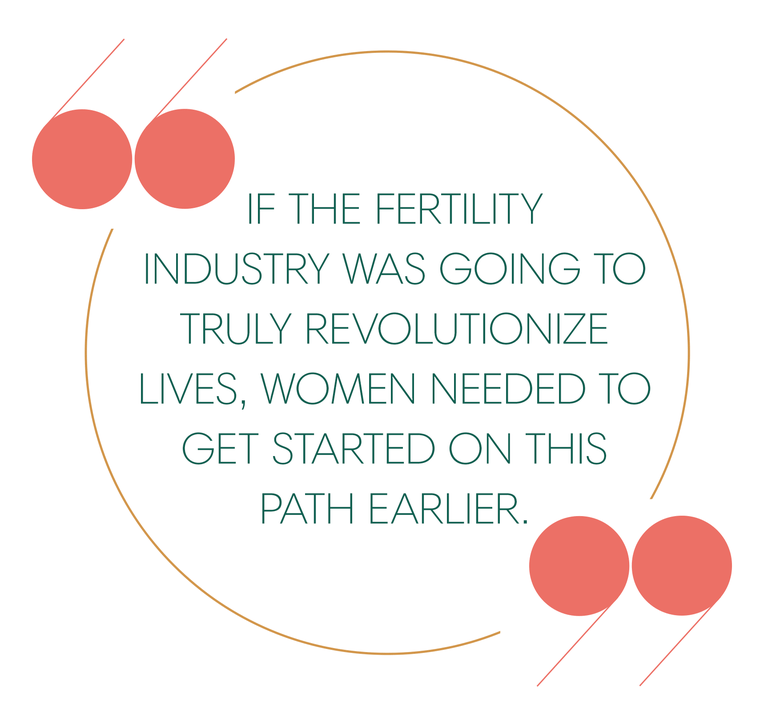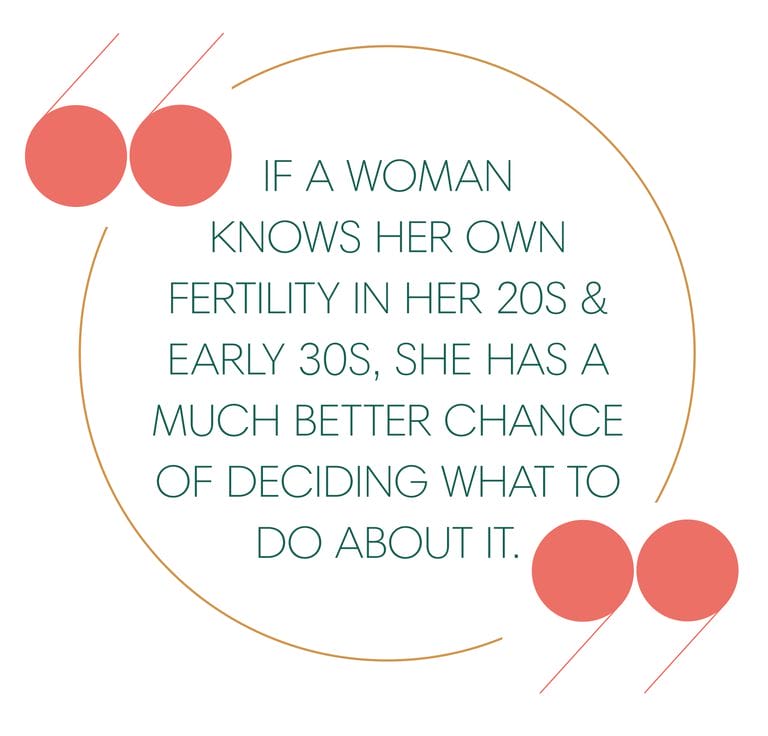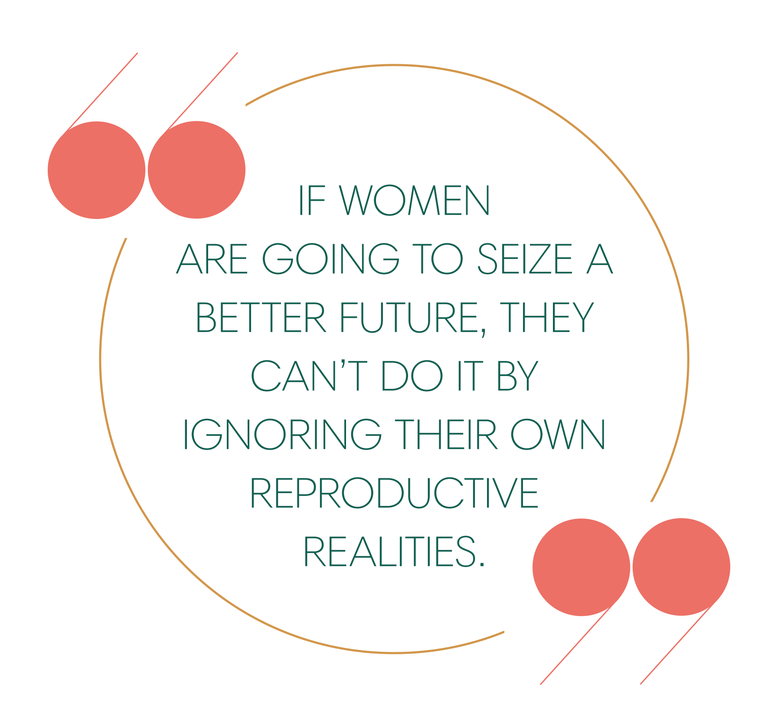
Moira Gilligan
In the days and weeks following her first fertility checkup, Sophie kept dropping this line at the bar. “I’m chock full of eggs!” she would say, and she and her girlfriends would laugh and clink glasses.
The line had been given to her by Dr. Alan Copperman, one of the top reproductive endocrinologists in Manhattan, who said it after examining a grainy ultrasound that revealed the mysteries of Sophie’s uterus, like a flashlight turned down an unlit subway tunnel: here are the fallopian tubes, there the dark beans of the ovaries. See those tiny squiggles? Follicles.
At the age of 26, Sophie, who wanted to be referred to by her first name, wasn’t thinking about children. She often told her friends she didn’t want any, and they teased her that she was so adamant, she’d probably end up with 10 kids some day, but who knew? All that was a future unforetold, a land of mortgages and marriage licenses and adult decisions, and at any previous point in history, a young ambitious woman like Sophie could have easily gone another decade or more without knowing or even caring what she was working with down there.
But we have entered a new age of fertility enlightenment. A raft of apps, at-home tests, online communities, and female-centric business ventures aim to convince millennial women that fertility is no longer the domain of sad, defeated older women who waited too long, but rather necessary intel that will bend Mother Nature to their will.
In Manhattan, a yellow pop-up van called KindBody spent much of the summer parked in a few different locations around Midtown, offering fertility assessments for curious passersby, along with consultations on egg freezing and IVF targeted at women in their 20s and early 30s. KindBody plans to franchise across the country over the next five years, gunning for the same sophisticated market as SoulCycle and Drybar. “Own your (future),” reads the slogan on KindBody’s website, whose chic urban design suggests that the strong woman of tomorrow will not only control her reproductive destiny, but she will also use needless parentheses.
Much of this entrepreneurial fervor stems from advances in egg freezing, a technology that has evolved from an expensive, painful, and largely unsuccessful procedure to a kicky form of lifestyle insurance (if no less painful or expensive). Scientists began successfully flash-freezing eggs in 1999 and first offered the procedure to cancer patients. The process of hormonally stimulating ovulation in a woman’s body and then extracting the eggs and placing them in cryogenic storage was a compassionate way to preserve fertility prior to chemo, but it didn’t take a genius in a lab coat to see the potential for the larger population.
At a time when women were delaying marriage and childbirth, a procedure that allowed them to preserve healthy eggs—to stop time, essentially—was nothing but market opportunity. Five years ago, the American Society of Reproductive Medicine (ASRM) removed the experimental label from egg freezing, and the numbers started to climb. In 2009, fewer than 500 women in the United States froze their eggs. By 2016, that number had leapt to nearly 9,000. Two years later, we seem to be approaching a genuine trend.
I have watched the egg-freezing revolution from the corner of my eye with the hope and pinprick of grief known to the woman whose life might have turned out different—if only. I was 40 years old when I finally wrote my first book, and in the years that followed, another urge exploded in me: I wanted a baby. I’d always wanted a child (vaguely, hypothetically) but it wasn’t until accomplishing that career milestone that the desire turned real and pressing. Finally, I had the mental space, the money, the certitude. Unfortunately, I did not have the eggs.
I’m embarrassed to say this closing of the window came as a surprise to me. I’d nurtured a blithe confidence that I had plenty of time, but Mother Nature is a merciless scorekeeper, and a woman’s fertility only marches in one direction: downward. It’s largely thought that a woman is born with all the eggs she’s going to have, and when she’s in her twenties, 90 percent of her eggs are healthy. But by the time she’s in her forties, 90 percent of her eggs are unhealthy. Progress had provided women like me the kind of rich life that would have been unfathomable to previous generations, and yet like so many others, I was snared in some grim biological statistics. Put bluntly: Age matters, especially when it comes to a woman’s eggs.
Mine is but one among countless tales. Every day, infertility clinics fill up with successful, affluent, otherwise healthy couples who can not conceive for one reason or another. It was so unfair. We’d spent our teens and 20s trying so hard not to get pregnant, and now we were spending our middle years in fluorescent-lit doctor’s offices, learning about luteinizing hormone and cervical mucus and discovering how complicated reproduction really was. And expensive! One cycle of IVF can cost $20,000, between medications and doctor’s visits; and egg freezing costs about $10,00 for the harvesting alone. Facebook posts and TV shows and chat rooms have overflowed with stories of heartbreak, failure, the misery of injections, the gobsmacking price tag of doing what was meant to come naturally: creating a child in your own body.
Not all these complications stemmed from advanced age. America’s declining fertility rate is a fascinating social puzzle that prompts questions about our environment (phthalates, antibiotics), our health (the effects of tobacco, obesity, stress, anxiety), not to mention a few dissertation-level issues regarding economics and gender politics. But a woman’s age was a major limiting factor. Our biology had evolved so that young, hearty people would reproduce early and often, but Western culture had evolved so that young, hearty people could attend college, travel and make interesting mistakes and pursue meaningful careers, binge drink and Instagram their funny donuts and dick around on the Internet without feeling weighed down by the pressures of children. Did they even want kids? Maybe, maybe not. And all this lush and leafy indecision turns out to be perfectly fine if the answer is “not.” But for many of us, the answer was strongly the opposite, and yet this discovery was arriving right around the time our reproductive systems were closing down shop.
The system had a bug. Assisted reproductive technologies could make incredible things happen, and yet the women most likely to invest the time and money in a procedure like egg freezing were the ones over 35, the ones who didn’t have many healthy eggs in the first place.

If the fertility industry was going to truly revolutionize lives, women needed to get started on this path earlier. They needed to learn what they were dealing with at an age when they could do something about it—that’s part of what brought on this new trend toward fertility awareness for millennials. And so far, the push seems to be working
“We’re seeing a lot more women in their early 30s,” says Dr. Copperman, who co-founded Reproductive Medicine Associates of New York in 2001. He’s seeing girl friends arrive in groups to freeze their eggs, women who are all turning 30 or 35. Some of the women post pictures on social media of their tiny microscopic eggs. Call it the new selfie.
Sophie wasn’t quite ready for that step, but she understood that life was nothing if not unpredictable, and she thought a fertility checkup was a smart move. She visited Dr. Copperman’s midtown office, and sat in a waiting room lined with luscious large-format photos of Central Park, saturated with colors that were just a tad bolder than real life. Sophie found the whole experience eye-opening. It was wild to see her actual uterus, in that tractor-beam ultrasound shape she recognized from the movies. She walked into the office knowing nothing, and she walked out with a new catchphrase. “You’re chock full of eggs,” Dr. Copperman had told her, and she had to suppress a giggle.
The ability to test a woman’s fertility so fast and so easily is an innovation in itself. For many years, fertility tests were onerous and time-consuming; a woman had to go off the pill for at least two months, then slog into the clinic on a certain day of the month. More recent tests bypass that red tape. Dr. Copperman uses the AMH test, a simple blood draw that checks the levels of anti-Müllerian hormone in the blood levels, a reflection of a woman’s ovarian reserves, and results come back in a matter of hours. The test isn’t perfect, he explains, but along with a two-minute pelvic ultrasound and a face-to-face consultation to discuss a patient’s goals and medical history, he can get a pretty decent snapshot of a woman’s reproductive health. That may not seem like a big deal, but it’s potentially a game changer. If a woman knows her own fertility in her 20s and early 30s, she has a much better chance of deciding what to do about it.
Imagine the implications for those women, given the tricky questions they must navigate during those years. A woman with a healthy AMH level might feel more comfortable taking that big promotion in another town. A woman with a lower-than-average level may finally find the incentive she needs to kick out that douchebag on the couch and get serious about finding a partner. Women of child-bearing age (and their hand-wringing parents) have long had a slew of opinions and emotions regarding the status of their fertility, but they had no actual data. All of life is a gamble, of course. But in the confounding game of reproduction, wouldn’t it be better to know the cards you’re holding?
This is the principle behind Modern Fertility, an at-home fertility test designed for women 21-40. Started in San Francisco by 23andMe alum Afton Vechery and former creative strategist at Uber Everything, Carly Leahy, Modern Fertility retails for $199, a far lower price tag than a visit to a fertility clinic, which can cost as much as $1,500 depending on your insurance. The pin-prick test will not only look at AMH but also seven more hormones, and the site connects users to doctors and an online community.
“Millennials are waiting longer than any generation to have children, but no one is focused on education,” says co-Vechery. “We’re not pushing women toward procedures. This is an honest interpretation of your fertility right now.”
Like Kindbody and clinics like the one Dr. Copperman runs, Modern Fertility hopes to fill in a much-needed information gap in women’s health. Blame sex ed, blame a traditionally male-oriented medical establishment, but many women never learned how ovulation and reproduction work. When I mention to Vechery that over the past few years, I’ve been taken aback by how little I knew about my own body, she says, “That’s been the mantra we hear over and over again from women.”
Which is weird, right? Women today track their steps and their carbs and their menstrual cycles on their Apple watches and iPhones. Why shouldn’t they know their ovarian reserves? Modern Fertility hopes women will test themselves over the years, so they can see trends across time. Dr. Copperman has the same goal: young women getting their fertility tested not once, but periodically, as it changes over the years. In a perfect-world scenario, testing would start during high school at their annuals, along with PAP smear. Just one more part of their well-woman exam.
Of course one problem—and there are a few—is that nobody is sure just how useful this is going to prove.
“Unfortunately the only true test of getting pregnant is getting pregnant,” says Dr. Mary Jane Minkin, Clinical Professor of Obstetrics at Yale School of Medicine. As any woman who has tried and failed to conceive can attest, a number of unseen factors can frustrate reproduction. Your partner’s sperm count might be low (as men’s sperm count increasingly is). Your fallopian tubes might be blocked. The list goes on and on.
Egg freezing success rates are hard to come by—according to the Society for Assisted Reproductive Technology, 20,000 women have frozen their eggs and 15 percent have tried to thaw and use them, and the technology is advancing so rapidly it’s hard to get a solid grip on a current success rate. Estimates range from 85 to 95 percent, but that’s squishy, because we haven’t had time for the longitudinal studies. Though the ASRM lifted the experimental label on egg freezing, they have yet to endorse the practice as a way to preserve against declining fertility. “It comes with both personal and societal and scientific ramifications that we aren’t prepared to say we understand yet,” Eric Widra, then ASRM co-chair, told PBS in 2012.
Dr. Minkin is a fan of egg freezing, a procedure she calls “fabulous,” but she counsels caution. “This is an insurance policy that can give women extra time,” she says. “Nobody can give you any guarantees that if you freeze these eggs, they’re going to be fertilize-able.”
Dr. Minkin came to reproductive medicine nearly 50 years ago, at a time when pregnancy tests involved injecting a woman’s urine into a rabbit, waiting a couple of days, and seeing if the poor sucker died. Since then, she has watched the field emerge from the dark ages. The pill: one of the most important inventions of modern medicine. Home pregnancy tests in the late ’70s? Hallelujah. We’d gone from killing unsuspecting bunnies to peeing on a plastic stick in the privacy of our own bathrooms. Forty years ago, science brought us Louise Brown, the first test-tube baby, as IVF was then called, a term that had a creepy sci-fi vibe, like children were being harvested in glass beakers. Magazines cover stories on the ethics of meddling with Mother Nature. What would come from our tinkering? How much should humans try to hack the limits of our own body?
The answer from the general public turned out to be: a lot. Over the next four decades, the demand for assisted reproductive technologies exploded, as ethical questions only grew more intense: Womb surrogacy, egg donation, the ability to scan for and possibly eliminate genetic mutations. Scientists are currently working on a way for two women to reproduce by combining their eggs. Oh, it will happen. The question is when, and at what cost.

Leave it to capitalism to turn a free act into a multi-billion dollar industry. And whether all of this is a miracle, or a very dangerous game depends on your perspective and moral philosophy. What no one can deny is that even miracles come with complications. Egg harvesting hurts. Injecting yourself with hormones to endure an extraction surgery—and yes, egg freezing involves surgery—is painful. And while the process may crack open possibilities for the modern woman torn between career and biology, torn between waiting for the right partner and grabbing the next asshole who shows up during ovulation, it’s also an answer that can run up to $10,000 for the egg harvesting alone — followed by around $500 a year for storage, and later, when the right moment finally arrives, the cost of embryo implantation. Numbers vary greatly, but insurance companies rarely cover these exorbitant costs, and nobody I spoke to was hopeful they would, as they often do in European countries—one of the many frustrations of our broken health care system. Tech companies like Facebook and Twitter made headlines by announcing they would cover egg-freezing for female employees, and other Silicon Valley companies have followed suit, but for the vast majority of us, at least for now, the costs are out of pocket.
“I live in New York, and I can’t even afford a place to store my clothes, much less my eggs,” says Catherine, a 32-year-old who recently went in for a fertility check-up. Even for those not living in the country’s most unaffordable city, young people are rarely known for having an extra $10,000 lying around.
“I tell my patients who are parents to older children: finance them,” says Dr. Minkin. “You want to have grandchildren, your kid can’t afford this stuff, but you’ve got the bucks, so go ahead and freeze the eggs.”
Perhaps we’ll see a future when egg freezing becomes the new luxury gift—an extravagant college graduation or marriage present. It’s also possible that as competition emerges, costs will decline. Kindbody, the yellow pop-up fertility clinic, offers egg freezing starting at $5,000, about half of what many clinics charge, though a customer might reasonably ask whether paying less for a controversial procedure is a good idea, as well as whether such a momentous journey should start inside a yellow van.
But the search to control our reproductive destiny will continue, along with its inevitable consequences—outsized expectations, disappointment, the shock of discovering that nothing in life can ever be controlled. The choices available to women today are amazing, but overwhelming. Is egg freezing worth the risk? Do I really want to be a parent? Even for a woman like me, a 44-year-old with my sad emoji of a fertility count, I have choices, too: do I want to use an egg donor, for between $37,000 and $67,000? Do I want to look at adoption, starting at around $30,000? Do I want to settle in for a long child-free single-hood of Netflix? For most of human history, women didn’t ask these questions. The fact that we now can is our gift—and our burden.

Not long ago, I had dinner with two smart and ambitious 20-somethings in lower Manhattan when the subject of egg-freezing arose.
“This is starting to stress me out,” one of them said, taking a long sip of her cocktail. And I get it. So many things can weigh on a young woman’s mind: dicey career prospects, rising rents, global warming, the current political situation—does anyone really want to worry about ovarian reserve? I remember what it was like to be that age, how badly I didn’t want to be bothered by such details, but I also learned what it was like to emerge on the other side of 40, wishing I had known more. Wondering if some twist of fate or piece of information might have changed my fate, my answer is the same answer all of us face: Who knows?
But if women are going to seize a better future, as so many seem poised to do, they can’t do it by ignoring their own reproductive realities. The more we know about our bodies, the more agency we have. The more we learn about these emerging technologies, the less those industries can prey upon our hopes and dreams. And the best way to fight back against anxiety and uncertainty is education.
After Sophie came back from her fertility check-up, she started telling her friends about it. The conversation led to other conversations about miscarriages, and abortions, and concerns like endometriosis and polycystic ovarian syndrome. The word empowerment gets thrown around quite a bit in stories like this, and it’s usually in service of a product designed to separate women from their wallets. But this was the true power, Sophie thought —talking with other women about the deeply personal but utterly vital subject of our health, our bodies. She had no idea what the future would cook up for her, but for the moment, at least—she knew she had the eggs.
From: Harper’s BAZAAR US



